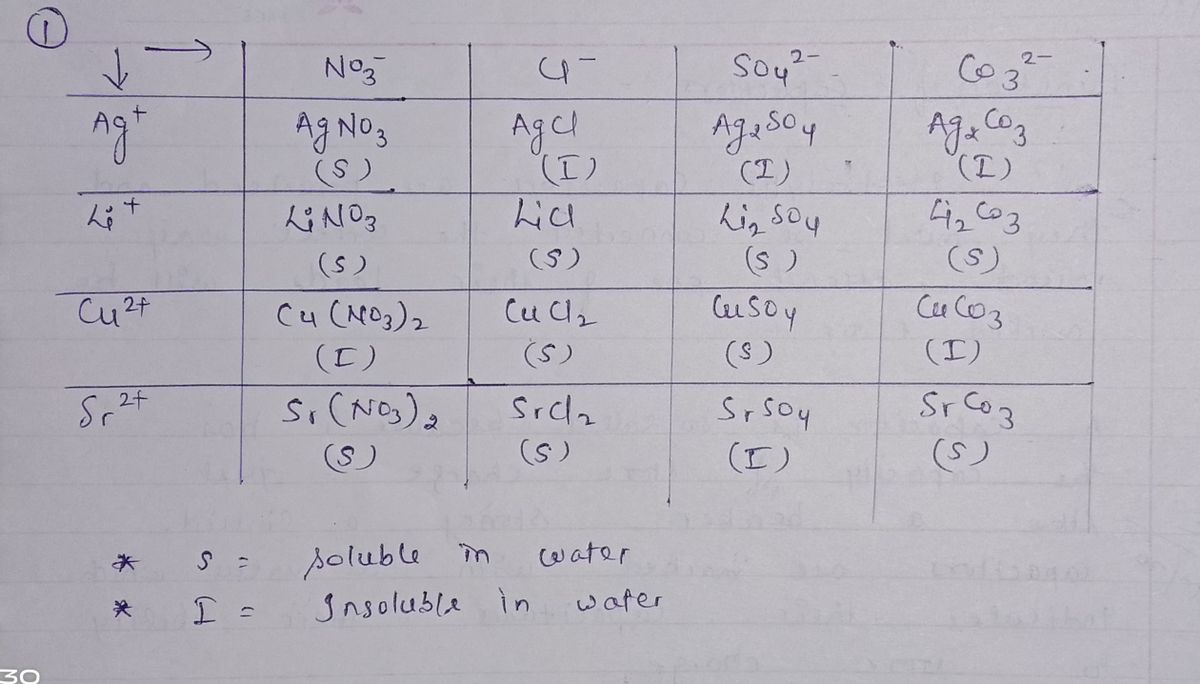1. Complete the following solubility table. (Simply enter S for soluble or I for insoluble in each cell). NO; Li* Ag" Cu²" Sr* 2. Write net ionic equations for those combinations that produce insoluble products. Ag + Co
1. Complete the following solubility table. (Simply enter S for soluble or I for insoluble in each cell). NO; Li* Ag" Cu²" Sr* 2. Write net ionic equations for those combinations that produce insoluble products. Ag + Co
Chemistry
10th Edition
ISBN:9781305957404
Author:Steven S. Zumdahl, Susan A. Zumdahl, Donald J. DeCoste
Publisher:Steven S. Zumdahl, Susan A. Zumdahl, Donald J. DeCoste
Chapter1: Chemical Foundations
Section: Chapter Questions
Problem 1RQ: Define and explain the differences between the following terms. a. law and theory b. theory and...
Related questions
Question
100%

Transcribed Image Text:14:52 Wed Feb 17
* 75%
T O
+ :
Name:
Date:
EXPERIMENT 2
QUALITATIVE CATION ANALYSIS
PRE-LABORATORY QUESTIONS
The following preparatory questions should be answered before coming to lab. They are intended
to introduce you to several ideas that are important to aspects of the experiment. You must turn
in your work to your instructor before you will be allowed to begin the experiment.
1. Complete the following solubility table. (Simply enter S for soluble or I for insoluble in
each cell).
NO3
SO2-
CO3²-
Cl
Li*
Ag*
I
Cu2+
Sr+
2. Write net ionic equations for those combinations that produce insoluble products.
Co
1
3
СHM 1024 — Ехрeriment 2. Qualitative Cation Analysis
Page 1 of 2
Expert Solution
Step 1

Trending now
This is a popular solution!
Step by step
Solved in 2 steps with 2 images

Knowledge Booster
Learn more about
Need a deep-dive on the concept behind this application? Look no further. Learn more about this topic, chemistry and related others by exploring similar questions and additional content below.Recommended textbooks for you

Chemistry
Chemistry
ISBN:
9781305957404
Author:
Steven S. Zumdahl, Susan A. Zumdahl, Donald J. DeCoste
Publisher:
Cengage Learning

Chemistry
Chemistry
ISBN:
9781259911156
Author:
Raymond Chang Dr., Jason Overby Professor
Publisher:
McGraw-Hill Education

Principles of Instrumental Analysis
Chemistry
ISBN:
9781305577213
Author:
Douglas A. Skoog, F. James Holler, Stanley R. Crouch
Publisher:
Cengage Learning

Chemistry
Chemistry
ISBN:
9781305957404
Author:
Steven S. Zumdahl, Susan A. Zumdahl, Donald J. DeCoste
Publisher:
Cengage Learning

Chemistry
Chemistry
ISBN:
9781259911156
Author:
Raymond Chang Dr., Jason Overby Professor
Publisher:
McGraw-Hill Education

Principles of Instrumental Analysis
Chemistry
ISBN:
9781305577213
Author:
Douglas A. Skoog, F. James Holler, Stanley R. Crouch
Publisher:
Cengage Learning

Organic Chemistry
Chemistry
ISBN:
9780078021558
Author:
Janice Gorzynski Smith Dr.
Publisher:
McGraw-Hill Education

Chemistry: Principles and Reactions
Chemistry
ISBN:
9781305079373
Author:
William L. Masterton, Cecile N. Hurley
Publisher:
Cengage Learning

Elementary Principles of Chemical Processes, Bind…
Chemistry
ISBN:
9781118431221
Author:
Richard M. Felder, Ronald W. Rousseau, Lisa G. Bullard
Publisher:
WILEY